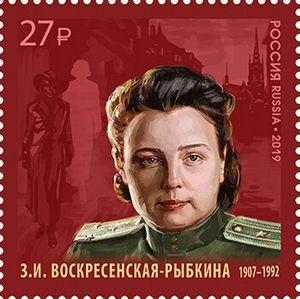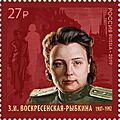Zoya Voskresenskaya facts for kids
Quick facts for kids
Zoya Voskresenskaya
|
|
|---|---|

Voskresenskaya on a 2019 stamp of Russia
|
|
| Born |
Zoya Ivanovna Voskresenskaya
Зоя Ивановна Воскресенская 28 April 1907 Uzlovaya, Tula Governorate, Russian Empire
|
| Died | 12 April 1992 (aged 84) |
| Occupation | diplomat Soviet secret agent author |
| Years active | 1930s – 1992 |
| Spouse(s) | Boris Rybkin |
| Awards | Order of Lenin Order of the Red Banner of Labour USSR State Prize (1968) |
Zoya Ivanovna Voskresenskaya (Russian: Зоя Ивановна Воскресенская; later known as Rybkina) was born on April 28, 1907, and passed away on January 8, 1992. She was a Soviet diplomat, a secret agent for the Soviet intelligence service, and a very popular author of books for children in the 1960s and 70s.
Zoya Voskresenskaya won the USSR State Prize in 1968. She was best known for her novels Skvoz Ledyanuyu Mglu (Through Icy Haze, 1962) and Serdtse Materi (A Mother's Heart, 1965). Between 1962 and 1980, more than 21 million of her books were sold in the Soviet Union.
In the late 1980s, when many old secrets were allowed to be shared, Zoya Voskresenskaya's true story became public. People learned that this popular children's writer had been a leading figure in the Soviet intelligence service's foreign department for 25 years. Voskresenskaya's memories from the war, titled Now I Can Tell the Truth, were published in 1992, just 11 months after she passed away.
Contents
Early Life and Intelligence Work
Zoya Voskresenskaya was born in Uzlovaya, a town in the Tula region of Russia. Her father worked at a railway station. She spent her early childhood in Aleksin. When she was ten, her father died, and her mother moved with Zoya and her two siblings to Smolensk.
At 14, Zoya started working as a librarian for a special police unit in Smolensk. Two years later, in 1923, she became a tutor and political instructor for young people in a local reform school. She then moved to a regional office of the Communist Party in Smolensk.
In 1928, Voskresenskaya moved to Moscow. In August 1929, she joined the foreign office of the OGPU, which was a Soviet intelligence agency. Her first assignment in 1930 was in Harbin, a city in Manchuria. After two years of gathering information there, she was moved to Riga, Latvia, and then to Germany and Austria.
Secret Missions in Europe
In 1935, Voskresenskaya began working in Helsinki, Finland. She pretended to be an official named 'Irina' for a travel agency called Intourist. She worked as a Soviet secret agent with Boris Rybkin, who was also a secret agent and an Embassy councilor. They soon got married.
When the Winter War began, Zoya Voskresenskaya returned to Moscow. Over the next few years, she became one of the top analysts in the Soviet intelligence service. She helped guide the work of several spy groups, including 'Rote Kapelle' in Germany. In 1940, she sent a secret report to Joseph Stalin about Germany's upcoming invasion.
World War II Efforts
When World War II started, Voskresenskaya joined a group led by Pavel Sudoplatov. This group trained people for secret missions and guerrilla warfare in areas taken over by the enemy. She even trained the very first reconnaissance unit sent to the Soviet Union's western border.
Voskresenskaya was preparing to be sent to occupied areas, pretending to be a railway station guard. However, in late 1941, she and Rybkin were sent to Sweden. There, she joined the Soviet embassy as a press assistant for Alexandra Kollontai, using the name 'madam Yartseva'. As a secret agent, she continued to guide various spy groups and individual agents. She collected information about German troop movements near the Swedish border. Both women, working closely together, were later recognized for helping Sweden stay neutral throughout the war. They also helped Finland leave the war and sign a peace treaty with the Soviet Union in September 1944.
After the war, Voskresenskaya continued working in Moscow. In the late 1940s, she became the head of the Soviet Intelligence's German department. In 1947, her husband Boris Rybkin died, supposedly in a car crash near Prague. Voskresenskaya did not believe the official story, but she was not allowed to investigate the case herself.
After Stalin's death in 1953, many people in the intelligence service were removed from their jobs. Voskresenskaya was upset when her former boss, Pavel Sudoplatov, was arrested and spoke up to defend him. She was almost immediately told to retire. However, she asked for a special permission to remain an officer and was sent to a labor camp in Vorkuta. There, she worked as the head of a small department, holding the rank of lieutenant.
Literary Career
In 1955, Voskresenskaya, who had reached the rank of colonel in the Interior Ministry, retired from her service. She then began a new career as a writer. She became quite famous in the 1960s for her children's books.
Her popular novels include:
- Skvoz Ledyanuyu Mgly (Through the Icy Haze, 1962)
- Vstretcha (The Encounter, 1963)
- Serdtse Materi (Mother's Heart, 1965), which was about Maria Alexandrovna Ulyanova and was even made into a movie in 1965.
- Devochka v Burnom More (Girl in the Stormy Sea, 1969)
- Dorogoye Imya (The Dear Name, 1970)
Between 1962 and 1980, 21.6 million copies of her books were published. This made Zoya Voskresenskaya one of the most important figures in Soviet children's literature. Several of her books were even included on school lists for extra reading.
In the late 1980s, when many secret documents from the Stalin era were made public, Voskresenskaya's story was finally revealed. She was already very ill at the time, but she began writing her memories. Her book, Teper Ya Mogu Skazat Pravdu (Now I Can Tell the Truth), was published in 1992, 11 months after she passed away on January 8 of that year. She was buried at the Novodevichye Cemetery in Moscow.
Images for kids


